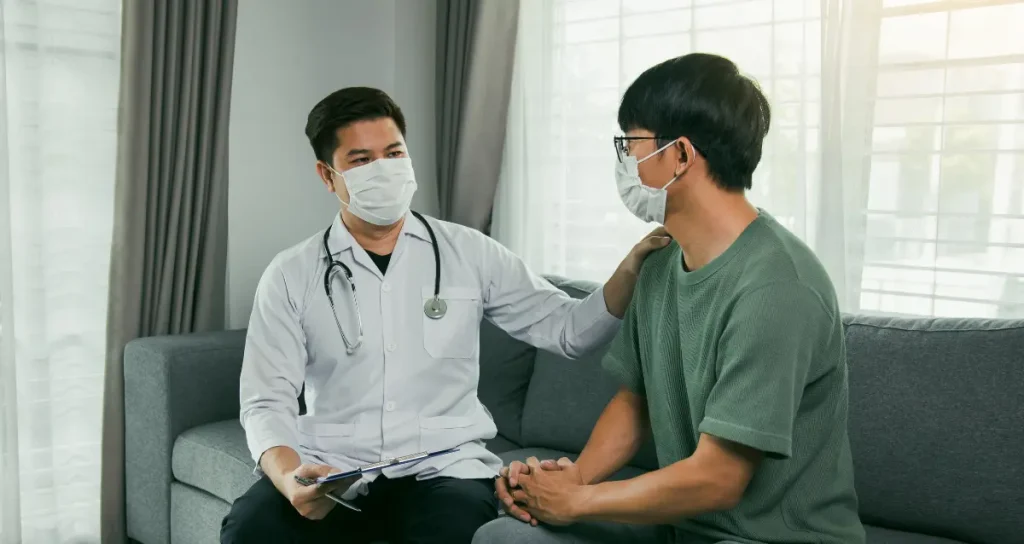
Long COVID, also known as post-acute sequelae of SARS-CoV-2 infection (PASC), refers to persistent symptoms that continue for weeks or months after the acute phase of COVID-19. While most individuals recover from COVID-19 within a few weeks, a significant number experience lingering effects that disrupt their daily lives and overall well-being.
The exact cause is still being researched, but experts believe it may result from a combination of factors, including viral persistence, immune dysregulation, and organ damage. The SARS-CoV-2 virus can persist in certain tissues, triggering immune responses that cause inflammation and damage to various organs and systems in the body.
Common Symptoms and Their Variations
Long COVID can manifest in a wide range of symptoms, affecting different individuals in different ways. While the most reported symptoms include fatigue, shortness of breath, brain fog, and muscle weakness, patients may also experience symptoms such as heart palpitations, joint pain, sleep disturbances, and gastrointestinal problems.
The severity and duration of symptoms can vary significantly among sufferers. Some individuals may experience mild symptoms that gradually improve over time, while others may have more severe and persistent symptoms that significantly impact their quality of life. Healthcare providers need to recognize the diversity of symptoms and tailor treatment plans accordingly.
Developing a Comprehensive Care Plan
Establishing a Multidisciplinary Team
Providing comprehensive care for long COVID sufferers requires a multidisciplinary approach that involves healthcare professionals from various specialties. A team may consist of primary care physicians, pulmonologists, physical therapists, mental health professionals, and other specialists, depending on the specific needs of each patient.
The collaboration of experts enables a comprehensive evaluation of the patient’s condition, ensuring that all aspects of their health are addressed. The team can work together to develop a personalized care plan that includes medical interventions, rehabilitation, counseling, and ongoing support.
Assessing the Unique Needs of Patients
Each patient has unique needs that require careful evaluation and assessment. It is crucial to conduct a comprehensive medical history review, physical examination, and specialized tests to identify any underlying organ damage or complications resulting from the initial COVID-19 infection.
In addition to the physical assessment, it is essential to consider the patient’s functional limitations, mental health status, and social circumstances. Understanding these factors helps healthcare providers tailor a care plan that addresses the specific challenges faced by sufferers.
Creating Individualized Treatment and Rehabilitation Protocols
Based on the assessment of each patient, individualized treatment and rehabilitation protocols should be developed to target their specific needs. This may include a combination of medical interventions, such as medications to manage symptoms or prevent complications, as well as non-pharmacological interventions like physical therapy and occupational therapy.
Physical rehabilitation is a crucial component of care, as it helps patients rebuild strength, improve endurance, and regain functional abilities. Physical therapists can create personalized exercise programs, incorporating aerobic conditioning, strength training, and flexibility exercises, based on the patient’s current abilities and goals.
In addition to conventional therapy, alternative treatments such as acupuncture, myofascial release, and hydrotherapy may also be considered to support the recovery process. These therapies can help manage pain, reduce inflammation, and improve overall well-being.

Addressing Physical and Emotional Challenges in Recovery
Effective Physical Therapy Techniques for Rehabilitation
Physical therapy plays a crucial role in helping patients regain physical function and improve their quality of life. Therapists employ various techniques and modalities to address the specific challenges faced by each individual.
One effective technique used in rehabilitation is pulmonary rehabilitation. This specialized program focuses on improving respiratory function, reducing breathlessness, and enhancing overall endurance through targeted exercises and breathing techniques.
Another valuable aspect of physical therapy is exercise therapy. Exercise programs are tailored to the patient’s current abilities, gradually progressing in intensity and duration. Regular exercise can help improve cardiovascular fitness, muscle strength, and overall energy levels.
Exploring Alternative Therapies to Support Recovery
In addition to conventional physical therapy techniques, alternative therapies can complement the rehabilitation process. These therapies aim to address physical and emotional challenges by targeting different aspects of the individual’s well-being.
Acupuncture, an ancient Chinese practice, involves the insertion of thin needles into specific points on the body to stimulate healing and alleviate symptoms. Many patients report positive effects on pain management, sleep quality, and overall emotional well-being after receiving acupuncture treatments.
Massage therapy can also be beneficial in reducing muscle tension, promoting relaxation, and relieving pain. It helps increase blood circulation, release endorphins, and improve mobility, which can be particularly helpful for individuals experiencing muscle weakness and stiffness.
The Role of Counseling and Mental Health Support
Living with long COVID can have a profound psychological impact on patients. The persistent symptoms, lifestyle limitations, and uncertainty about the future can lead to anxiety, depression, and other psychological concerns.
Counseling and mental health support should be an integral part of the care plan. Mental health professionals can provide individual therapy sessions or facilitate support groups to help patients cope with the emotional aspects of their condition. These sessions can offer guidance, education, and a safe space for individuals to express their thoughts and feelings.
Supporting Patients and Their Families
Building a Strong Support Network
Recovery can be a challenging and isolating journey for both patients and their families. Building a strong support network is essential to provide emotional support, share experiences, and offer practical help.
Support groups specifically focused on post-viral syndromes can be a valuable resource for patients and their families. These groups enable individuals to connect with others who are going through similar experiences, exchange information on coping strategies, and provide mutual encouragement.
Additionally, healthcare providers should encourage open communication between patients and their loved ones. This communication fosters a supportive environment where patients feel understood, heard, and valued throughout their recovery process.
Practical Tips for Managing Everyday Life
The condition can have a significant impact on patients’ ability to carry out daily activities and responsibilities. Providing practical tips and strategies for managing everyday life is crucial in helping patients regain a sense of control and independence.
Some practical tips may include creating a structured routine, conserving energy through pacing activities, and using assistive devices or adaptive equipment to compensate for any physical limitations. Patients can also benefit from learning stress-management techniques, such as deep breathing exercises and mindfulness practices, to manage anxiety and improve overall well-being.
The Importance of Advocacy and Community Engagement
Advocacy and community engagement play a vital role in raising awareness and improving support and resources for patients. By becoming advocates, patients and their families can make a meaningful impact in shaping policies, promoting research funding, and reducing the stigma associated with long COVID.
Engaging with online communities, participating in research studies, or volunteering for organizations dedicated to long COVID can provide patients and their families with a sense of purpose and empowerment. It allows them to connect with others, share their experiences, and contribute to a greater understanding of the condition.
Conclusion
Providing comprehensive care for long COVID patients involves understanding the unique challenges they face, developing personalized treatment plans, and addressing both the physical and emotional aspects of their recovery. By taking a multidisciplinary approach, healthcare providers can support patients through their journey to healing, empowering them to reclaim their lives and well-being.
FURTHER READING









